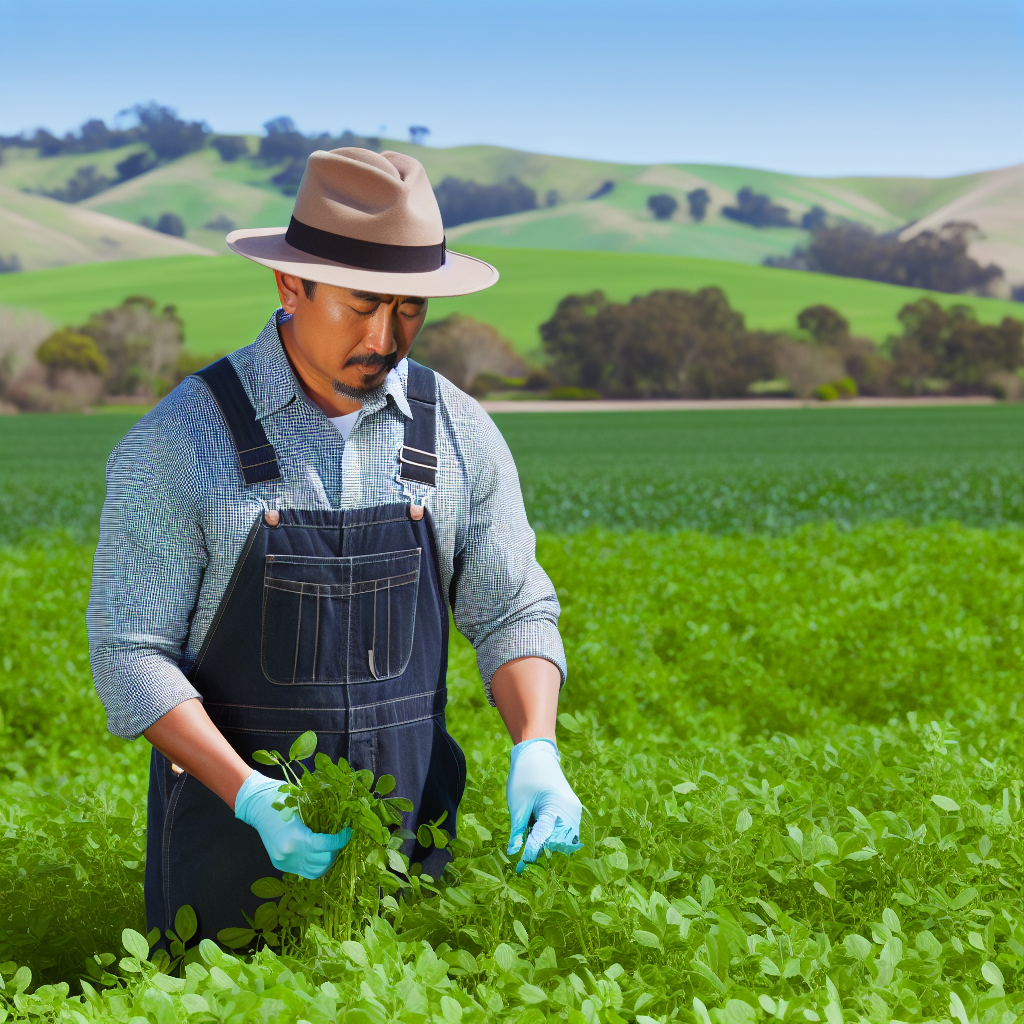Introduction to Cover Crops
Cover crops play a vital role in sustainable agriculture.
They help improve soil health and fertility.
Additionally, they reduce erosion and nutrient runoff.
Farmers use cover crops to manage pests and diseases.
This practice offers multiple ecological benefits.
Improving Soil Structure and Health
Planting cover crops enhances soil structure over time.
Roots of cover crops create channels in the soil.
These channels improve water infiltration and aeration.
Moreover, they contribute organic matter to the soil.
This organic matter increases microbial activity.
Pest and Disease Suppression
Cover crops can help suppress pest populations.
Certain species release substances that deter pests.
For example, mustard crops repel nematodes and aphids.
Additionally, cover crops disrupt pest life cycles.
This disruption lowers the chances of pest outbreaks.
Transform Your Agribusiness
Unlock your farm's potential with expert advice tailored to your needs. Get actionable steps that drive real results.
Get StartedWeed Management Advantages
Cover crops effectively suppress weed growth.
Their dense foliage shades out weeds and limits sunlight.
Furthermore, they outcompete weeds for nutrients and water.
Farmers can reduce herbicide use because of cover crops.
Enhancing Biodiversity
Cover crops promote biodiversity in agricultural ecosystems.
Diverse plant species attract beneficial insects and pollinators.
These beneficial organisms help manage pests naturally.
Increased biodiversity enhances overall ecosystem resilience.
Long-Term Sustainability
Using cover crops leads to long-term agricultural sustainability.
Farmers notice improved soil quality and productivity over time.
Additionally, healthier soils contribute to robust crop yields.
This approach ensures food security for future generations.
Types of Cover Crops Beneficial for Pest and Disease Management
Leguminous Cover Crops
Leguminous cover crops improve soil health through nitrogen fixation.
They boost soil fertility, which enhances plant growth.
Common types include clover, vetch, and pea.
These crops attract beneficial insects that help control pests.
Moreover, they can suppress weeds effectively.
Cereal Cover Crops
Cereal cover crops such as rye and oats contribute to soil structure.
They enhance water infiltration and reduce erosion.
Additionally, these crops provide habitat for predatory insects.
By breaking pest cycles, they help manage crop diseases.
Furthermore, they can outcompete harmful weeds.
Brassica Cover Crops
Brassicas like mustard and radish are excellent for pest control.
They produce biofumigants that suppress soil-borne diseases.
Showcase Your Farming Business
Publish your professional farming services profile on our blog for a one-time fee of $200 and reach a dedicated audience of farmers and agribusiness owners.
Publish Your ProfileTheir deep roots improve soil aeration and nutrient uptake.
Moreover, these crops deter pests like nematodes and aphids.
They serve as a host for beneficial insects as well.
Broadleaf Cover Crops
Broadleaf cover crops, such as buckwheat, thrive in various conditions.
They attract pollinators and other beneficial wildlife.
Their quick growth provides excellent soil coverage.
Additionally, they can help suppress certain weed species.
They also contribute organic matter to the soil upon decomposition.
Mixes of Cover Crops
Combining several cover crops creates diverse benefits.
This diversity enhances soil health and pest management.
It allows for the complementary benefits of different species.
Mixtures can reduce pest populations more effectively than single crops.
Furthermore, they improve resilience against diseases.
Mechanisms of Pest Suppression through Cover Crops
Natural Pest Predators
Cover crops attract beneficial insects and natural pest predators.
These insects help control pest populations naturally.
For instance, ladybugs and lacewings prey on aphids.
Thus, cover crops can reduce reliance on chemical pesticides.
Soil Health Enhancement
Cover crops improve soil structure and fertility.
Healthy soil supports diverse microbial communities.
These microbes can suppress soil-borne diseases and pests.
As a result, plants become more resilient to pest attacks.
Allelopathic Compounds
Some cover crops release allelopathic compounds.
These compounds inhibit the growth of specific weeds and pests.
For example, sorghum-sudangrass can suppress nematodes.
This biological control further enhances pest management.
Companion Planting Synergy
Incorporating cover crops can act as companion plants.
This method utilizes plant diversity to enhance pest resistance.
Companion plants can mask the scent of crops that attract pests.
As a bonus, they can provide habitats for beneficial insects.
Increased Organic Matter
Cover crops contribute organic matter to the soil when terminated.
This organic matter increases nutrient availability for crops.
Healthy plants are often less susceptible to pest infestations.
Moreover, they support a more robust ecosystem in the garden.
Moisture Retention
Cover crops help retain moisture in the soil.
This is crucial during dry spells, which stress plants.
Stressed plants are more vulnerable to pests and diseases.
By retaining moisture, cover crops promote healthier crops.
Establishing a Diverse Farm Ecosystem
Planting a variety of cover crops establishes a diverse farm ecosystem.
Diversity increases resilience against pest outbreaks.
This balance encourages a mix of predator and prey dynamics.
Showcase Your Farming Business
Publish your professional farming services profile on our blog for a one-time fee of $200 and reach a dedicated audience of farmers and agribusiness owners.
Publish Your ProfileUltimately, this leads to sustainable pest management practices.
You Might Also Like: Preventing Soil Degradation with Smart Practices
Integrating Cover Crops into Crop Rotation for Disease Control
Importance of Crop Rotation
Crop rotation is crucial for managing pests and diseases.
It disrupts the lifecycle of pathogens and pests.
Additionally, it enhances soil health and fertility.
Using cover crops during rotation maximizes these benefits.
Choosing the Right Cover Crops
Select cover crops based on your main crops and local conditions.
Legumes like clover fix nitrogen, improving soil fertility.
Brassicas such as radishes suppress diseases and pests effectively.
Other options include oats and rye, which enhance soil structure.
Timing and Management of Cover Crops
Timing is essential when integrating cover crops into rotations.
Plant cover crops after the main crop harvest.
Terminate them before planting the next cash crop.
Proper management reduces competition for nutrients and moisture.
Benefits of Using Cover Crops for Disease Control
Cover crops improve soil health through organic matter addition.
They also enhance biodiversity, promoting beneficial organisms.
These practices lead to fewer diseases and pests overall.
Moreover, cover crops can break disease cycles effectively.
Monitoring and Evaluation
Regular monitoring helps assess the effectiveness of cover crops.
Keep records of disease incidence and pest populations.
This data aids in adjusting cover crop strategies as needed.
Furthermore, it fosters continuous improvement in pest management.
Uncover the Details: Integrated Pest Management After Harvest
Soil Health Improvement from Cover Cropping Practices
Introduction to Cover Crops
Cover crops play a vital role in enhancing soil health.
They protect against erosion and improve moisture retention.
Additionally, they can suppress weeds effectively.
Nutrient Management
Cover crops contribute to nutrient cycling in the soil.
Leguminous cover crops fix nitrogen, benefiting subsequent crops.
This process reduces the need for synthetic fertilizers.
Improving Soil Structure
Planting cover crops enhances soil structure over time.
Their root systems create channels in the soil.
This allows better air and water movement.
Well-structured soil promotes root growth for cash crops.
Microbial Activity
Cover crops boost beneficial microbial populations in the soil.
These microbes enhance organic matter decomposition.
As a result, they improve nutrient availability for plants.
Enhancing Biodiversity
Using diverse cover crop species promotes biodiversity.
This diversity supports insect populations, both beneficial and pest species.
Moreover, it encourages a balanced ecosystem in agricultural fields.
Reducing Soil Compaction
Cover crops help alleviate soil compaction issues.
Showcase Your Farming Business
Publish your professional farming services profile on our blog for a one-time fee of $200 and reach a dedicated audience of farmers and agribusiness owners.
Publish Your ProfileTheir roots penetrate compacted layers, breaking them up.
This action improves water infiltration and root growth.
Long-term Soil Benefits
Practicing cover cropping leads to long-term soil benefits.
Healthy soil can retain more nutrients and moisture over time.
Ultimately, this results in increased crop yields and resilience.
Learn More: Choosing the Right Cover Crop for Your Farm

Economic Considerations of Using Cover Crops for Pest Management
Cost Savings and Yield Improvements
Implementing cover crops can lead to significant cost savings for farmers.
These savings often stem from reduced pest control expenses.
Cover crops can naturally suppress pest populations.
Consequently, this reduces the need for chemical pesticides.
Moreover, studies show that cover crops can improve overall yields.
Healthy plants tend to resist pests better than weaker ones.
Thus, investing in cover crops enhances both soil and plant health.
Initial Investment vs. Long-term Benefits
Many farmers hesitate due to initial investment costs.
However, the long-term benefits usually outweigh these costs.
Cover crops improve soil fertility and structure over time.
Healthy soil can yield more crops and reduce erosion.
Moreover, reduced reliance on fertilizers lowers ongoing expenses.
Farmers can see a return on investment within a few growing seasons.
Market Trends and Consumer Demand
There is a growing trend toward sustainable agriculture.
Consumers increasingly prefer products grown with environmentally friendly practices.
This demand can lead to higher prices for sustainably produced crops.
Farmers using cover crops may access new markets.
This can create opportunities for premium pricing.
Adapting to market trends can enhance a farmer’s competitive edge.
Government Incentives and Programs
Many governments offer incentives for sustainable practices.
Financial assistance can ease the burden of implementing cover crops.
Programs may include grants, tax breaks, or cost-share programs.
Farmers should explore local resources for assistance.
Utilizing these programs enhances the economic viability of cover cropping.
Gain More Insights: Remote Sensing Technologies In Agricultural Management
Case Studies of Successful Pest Management Using Cover Crops
Introduction to Cover Crop Strategies
Cover crops play a crucial role in pest management.
They boost soil health and enhance biodiversity.
Farmers adopt various strategies to manage pests effectively.
A Successful Example: Bob’s Organic Farm
Bob’s Organic Farm in Ohio implemented a cover crop rotation.
He introduced vetch and rye to improve soil nutrients.
As a result, his farm saw a decrease in aphid infestations.
This shift minimized the need for chemical pesticides.
Additionally, the cover crops attracted beneficial insects.
Leveraging Brassicas: Sarah’s Vegetable Garden
Sarah transformed her vegetable garden using mustard cover crops.
Showcase Your Farming Business
Publish your professional farming services profile on our blog for a one-time fee of $200 and reach a dedicated audience of farmers and agribusiness owners.
Publish Your ProfileShe noticed a reduction in nematode populations.
This transition led to healthier tomato plants.
Furthermore, her garden produced higher yields.
Diverse Planting on David’s Vineyard
David planted a mixture of clover and radish in his vineyard.
These cover crops suppressed weed growth effectively.
Moreover, they reduced the prevalence of grapevine moths.
David reported improved grape quality and flavor.
Innovative Approaches in Community Gardens
Community gardens adopted multi-species cover crops for pest control.
This method increased resilience against pest outbreaks.
Participants shared their experiences and improved techniques.
As a result, community engagement and educational opportunities flourished.
Future Directions in Sustainable Pest Management
These case studies highlight the effectiveness of cover crops.
Farmers and gardeners can reduce pest issues sustainably.
Such practices support ecological farming and food security.
Ultimately, embracing cover crops benefits both producers and consumers.
Challenges and Limitations of Implementing Cover Crops in Pest and Disease Management
Initial Investment and Costs
Implementing cover crops often requires upfront financial investment.
Farmers need to purchase seeds and possibly new equipment.
These initial costs can deter many from adopting cover cropping practices.
Knowledge and Experience Barriers
Many farmers lack experience with cover crops.
They may not understand which species to choose for their specific conditions.
Limited knowledge can lead to improper implementation and poor results.
Management Complexity
Managing cover crops increases overall farm complexity.
Farmers must effectively integrate them into existing crop rotations.
This added complexity can overwhelm some growers.
Potential Pest Concerns
Some farmers worry cover crops might harbor pests and diseases.
Newly introduced plants can attract unwanted pests.
Proper monitoring and management are essential to mitigate risks.
Seasonal Limitations
Seasonal weather patterns can affect cover crops’ viability.
Extreme weather can damage crops before they fulfill their purpose.
This unpredictability can limit the effectiveness of cover cropping strategies.
Regulatory and Policy Constraints
In some regions, regulations may discourage cover cropping practices.
Farmers may face restrictions or lack support from local policies.
This can hinder the adoption of beneficial pest management practices.




